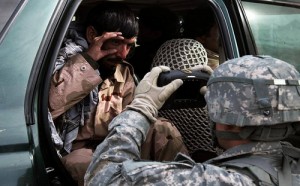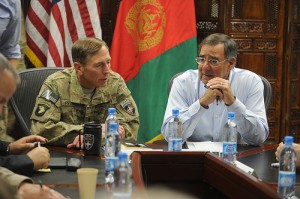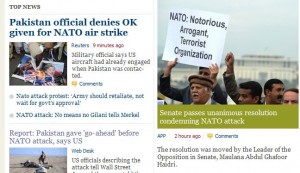Taliban Role Large in Green on Green Attacks
At least eleven Afghan soldiers were killed yesterday in two separate attacks. The Taliban has claimed responsibility for both attacks. In the Washington Post’s coverage of the attacks, they take second billing to the attack on the NATO fuel tankers. In both cases, however, apparent Afghan soldiers were involved in the attacks on their fellow troops:
Afghan authorities were investigating whether the checkpoint attack in Helmand’s remote and arid Washer district was organized with the help of an Afghan soldier whose whereabouts since the raid were unknown, said Daud Ahmadi, a spokesman for Helmand’s governor.
“Police reinforcements were sent, and they killed seven Taliban in gun battles,” Ahmadi said.
“We suspect the missing soldier was involved in a plot in the killings of the nine army soldiers but have to investigate this point,” he said.
/snip/
Also Wednesday, a man wearing an Afghan army uniform blew himself up at a checkpoint in the eastern province of Logar, killing three Afghan troops, the Associated Press reported. The Taliban asserted responsibility for the attack.
The New York Times devotes a separate article to the two attacks, and places it in a larger context of increasing deaths among Afghan troops, many of which they attribute to Taliban infiltration of the ranks of Afghan forces. [The Times places the death toll at 11 instead of 12, reporting only 2 deaths in the suicide bombing instead of 3.] The Times notes the strategy behind the Taliban’s attacks:
With the American-led coalition increasingly ceding a greater role in the fight to Afghan forces, one of the chief aims of the Taliban and its insurgent allies has been to show that the Afghan Army and police force are incapable of protecting themselves, never mind ordinary people.
The article goes on to note that there have been 227 deaths of Afghan forces in the last four months, compared to 162 coalition deaths. A rather harsh explanation is provided for why this is noteworthy:
While General Azimi offered no comparative data for Afghan casualties during the same period in previous years, the Afghan Army has in the past often suffered fewer deaths than coalition forces because its soldiers tended to back away from fighting the Taliban.
The Times discusses the infiltration strategy of the Taliban while relaying results of an Afghan court convicting an Afghan soldier in an earlier green on blue attack that killed 4 French soldiers:
The Taliban said the convicted soldier was an infiltrator and praised him for his bravery. The insurgents routinely claim as their own Afghan soldiers who turn their weapons on coalition allies, although coalition and Afghan officials say most of the cases appear to be caused by personal animosity, not insurgent infiltration.
Since coalition reporting of green on blue events is so short on details, discriminating between true infiltrators and events where “personal animosity” takes over on the spur of the moment is not possible in all cases. However, yesterday’s event in which an Afghan soldier facilitated an attack by a larger group of the Taliban on an outpost is not the first time we have seen evidence of obvious coordination between an Afghan soldier and an outside group of attackers. Infiltration seems certain in these sorts of attacks.
The issue of infiltration is a bit murkier in the case of the suicide bomber. The Times points out that Afghan army uniforms are readily available for purchase. Since Afghanistan maintains a biometric database on its forces, if the suicide bomber’s body can be fingerprinted or a face or iris scan can be carried out, it will be possible to say with some certainty whether he was a member of the Afghan forces. Given the coalition’s hesitance to provide details, however, it seems very unlikely the results of such an analysis will be released.





